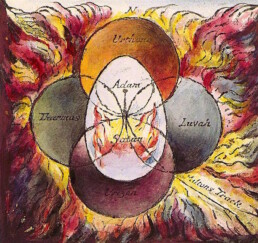DIAGRAM of WILLIAM BLAKE'S GODS
ALBION
Albion is the primordial man in William Blake’s mythology. He is a multifaceted figure representing: a prehistoric England, the original first man / giant / god, and the origin point of the four Zoas of Blake’s mythology. The character of Albion can be traced back to ancient Greek myths: he is a son of Poseidon who loses a battle against Heracles. Blake also uses Albion as a name for England in his poems.
Albion is the father of all mankind. Blake writes: “He is Albion, our Ancestor, patriarch of the Atlantic Continent, whose History Preceded that of the Hebrews & in whose Sleep, or Chaos, Creation began.”
In Blake’s mythos, Albion splits into four equal parts / energies, which become the four primary gods: Tharmas, Urizen, Luvah, and Urthona (Los); which make up our physical reality and psychology. It’s important to note the similarity found in older spiritual traditions which also feature a godlike primordial man who is broken up into pieces that form reality. In Kabbalah we find Adam Kadmon, in Gnosticism there is the Anthropos, etc.
It’s important to mention that Blake didn’t worship these gods. His aim was to mythologize our lived reality, and to critique orthodox Christianity by claiming the God of the Old Testament was Urizen. All indications show that Blake believed in a God and considered himself to be a Christian. But his version of Christianity is unlike any that we know and is inextricably linked with man’s creative capacity.
THE FOUR ZOAS
In The First Book of Urizen (1794), William Blake describes the creation of our reality after a god, Urizen, forms our universe out of a void. The action is seen by the Eternals as a selfish betrayal of eternity, causing him to be banished and severing his connection with the other gods. An Eternal named Los (Urthona’s name when in a physical manifestation) imprisons Urizen into our universe using chains he creates with his forge and blacksmith’s hammer.
The First Book of Urizen centers around these two gods: Urizen & Los, and the creation of our reality. But three years later (1797) Blake begins a new work in which he fleshes out the framework of all four Eternals––whom he calls The Four Zoas.
While researching for Creative Codex’s William Blake series, I scoured my Blake books and the internet for a proper diagram laying out the correspondences of Blake’s gods (The Four Zoas). To my dismay, I could not find any except a diagram Blake painted in Milton (1810) pictured here. I began to suspect that Blake must have drawn a more comprehensive diagram which showed the relationships between his gods––which he would have shown patrons––but this was lost or destroyed after his death. I’ve created the diagram at the top of this page for this purpose.
As my diagram shows (at the top of this page), The Four Zoas emerge from the quartering of Albion. Below this separation I’ve arranged the Zoas and their attributes in a table to more easily analyze their correspondences. This layout gives us an appreciation for the functional elegance of Blake’s mythological framework. We can observe:
- Each of the gods is paired with one of the four classical elements and compass directions. Tharmas–Water–West, Urizen–Air–South, Luvah–Fire–East, Los–Earth–North.
- The dynamic between the gods is mirrored in their attributes. (ex: Urizen and Los stand in opposition to one another just as North-South and Air-Earth are in opposition. In The First Book of Urizen, it’s Los who chains Urizen within the prison of space-time.)
- Blake further anchors the gods in our daily lives by associating each with a trait of human experience: Tharmas–senses, Urizen–reason, Luvah–emotions, Los–imagination.
Each of Zoas has a corresponding female emanation–just as Eve arose from Adam. These figures have traits which compliment those of their respective Zoa: Tharmas–senses–Enion–sexuality, Urizen–reason–Ahania–intellect, Luvah–emotions–Vala–nature, Los–imagination–Enitharmon–inspiration / spiritual beauty.
The mythological function of each god is symbolized by their profession and working tools: Tharmas–shepherd–sheephook, Urizen–builder–compass, Luvah–weaver–loom, Los–blacksmith–hammer. In The First Book of Urizen, Urizen uses the tools of stone workers to fashion reality:
“He form’d a line & a plummet to divide the Abyss beneath. He form’d a dividing rule: He formed scales to weigh; He formed massy weights; He formed a brazen quadrant; He formed golden compasses, And began to explore the Abyss, And he planted a garden of fruits…”
In one case, a Zoa and his emanation conceive a child–when Los & Enitharmon create Orc. Orc embodies the spirit of rebellion which, like all the Zoas & emanations, courses through each individual. It’s this rebellious spirit which prevents mortals from following Urizen’s laws, as set out in his Book of Brass. This convinces him to facet the Net of Religion which ensnares the minds of men.
Rough Draft Diagram of William Blake's Gods






